
Key considerations
- Available for £27,000 (V8), £39,000 (V10)
- 4.2-litre V8 or 5.2-litre V10 petrol, all-wheel drive
- Looks and sounds epic with either engine, especially as a Spyder
- Very secure handling, lovely manual gearboxes
- Cabins can seem unexciting but everything is very well-built
- Values seem to be bottoming out so now might be the time to buy
‘The best handling road car today.’ That’s how Jacky Ickx described the first-generation Audi R8 that we’re looking at here. We’re not 100 percent sure when ‘today’ was, but we think it was probably in, or at least close to, the year in which the production R8 went on sale, which was 2006.
The R8 had actually revealed itself three years before that, at the 2003 Geneva and Frankfurt shows. By that point, Audi had built a strong reputation on various fronts. In production motoring it was competing on at least an equal level with Mercedes and BMW, and its quattro all-wheel drive system had been a major factor in establishing it in the top echelon of motorsport.
Against that background, even taking into account the racing R8 LMP’s instant and lasting domination of endurance racing and what must have been a natural temptation to build on the massive success of the TT, the birth of the R8 was still a bit of a surprise. Its Geneva ’03 appearance came a full five years after the Volkswagen Audi Group had acquired the Lamborghini, Bugatti and Bentley marques, so most observers expected any new VAG sports car to wear one of those three badges. But there it was, a stunning two-seat mid-engined Audi coupé with a naturally aspirated 420hp 4.2 V8 or, a couple of years later, a 525hp 5.2 V10 engine from the Lamborghini Gallardo (on whose platform the R8 was based). Either engine could be hooked up to a 6-speed manual or a 6-speed R-Tronic torque converter auto. Eeeh, just imagine having all those choices now.
When the R8 went on sale in the UK in the early summer of 2007 it was meant to challenge the Porsche 911. It did that all right. The V8 was more powerful than a Carrera 4S and cheaper than a Turbo, and more relaxing than both when it was carrying your weary body home after a long flight. Perhaps most significantly the Audi felt more ‘special’ than the 911. People really noticed it, and rarely in a negative way. It lived up to its double-take looks too with its fine combination of mid-engine balance, quattro grip, lightweight construction and serious power. The V8 topped out at 187mph, the V10 at 196mph, so in performance terms they’re still completely relevant in 2025.
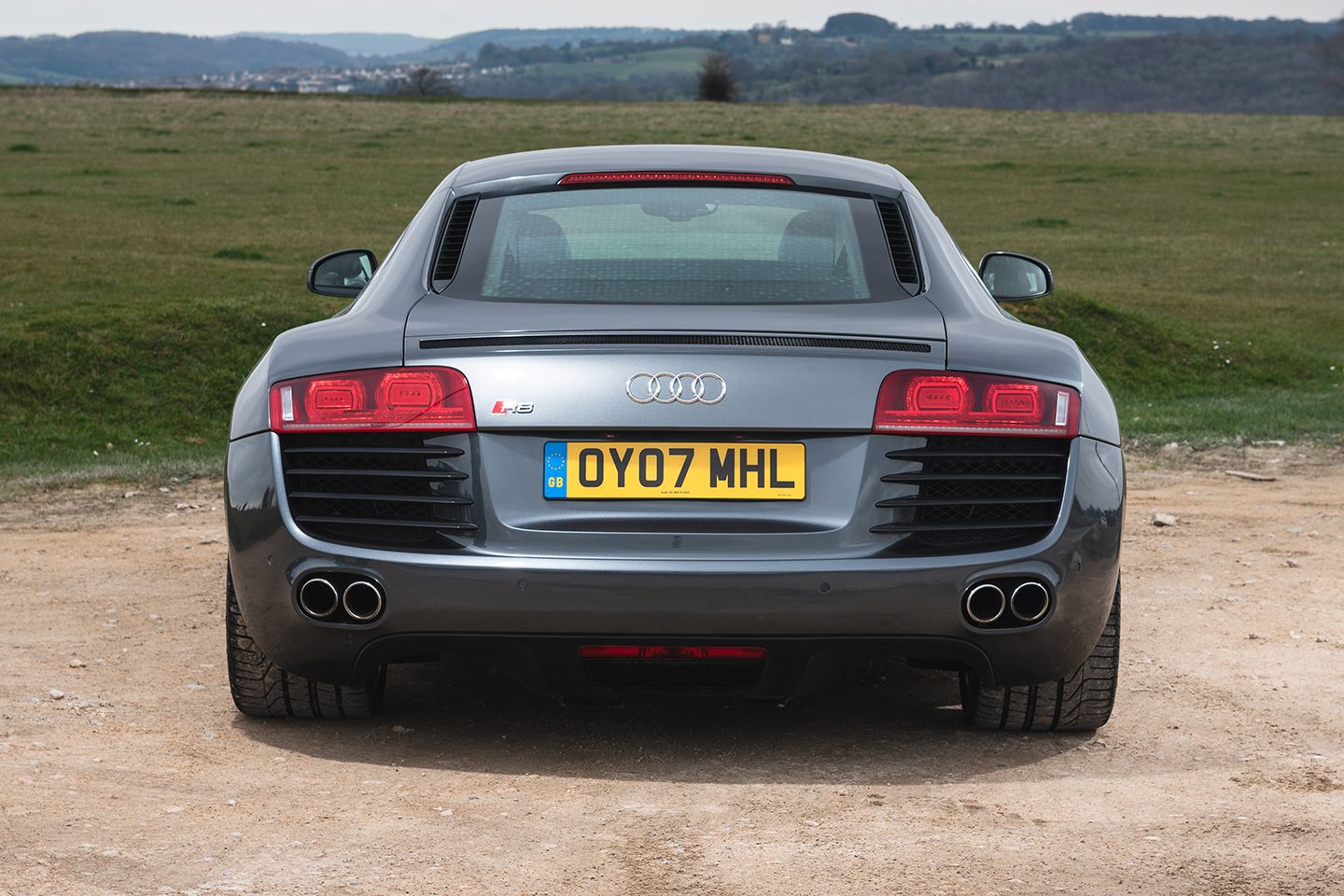
When the V10 arrived in UK showrooms in the Spring of 2009 it cost £99,575 for the manual (compared to £77,000 for the 2007 V8), or £104,665 for the auto, making it not just the fastest Audi ever but also the most expensive. The whooping V10 made it arguably the best-sounding Audi too if you didn’t count the supercharged V16 Auto Union racers from the 1930s.
The V8 cars’ power output was upgraded to 434hp in 2010, with a bonus improvement in fuel efficiency. Released in that same year were 33 R8 GTs with 560hp V10s and 100kg snipped off the weight. They covered the 0-62 in 3.6sec and went on to 199mph. 2010 was a busy year all round for the R8 as it brought the first R8 Spyder convertibles, initially V10s but later with the V8 and the GT versions. The convertibles did without the coupé’s distinctive sideblades and were quite a bit heavier than the coupés, some say by 30kg, others by 100kg.
They were quite a bit more expensive than the coupés too at £109,580 for the manual or £114,670 for the R tronic auto. Still, thanks to the incredible racket they gave you access to they greatly broadened the R8’s appeal.
An R8 V8 Limited Edition with titanium-coloured body paint and wheels and red brake calipers was launched in the Autumn of 2011 to mark Audi’s tenth win at Le Mans. A more powerful 550hp/398lb ft V10 Plus coupé-only model was added to the range in a big 2012 facelift. That had carbon ceramic brakes as standard. The automatic gearbox changed to the S tronic dual-clutcher at this time, another big step up.
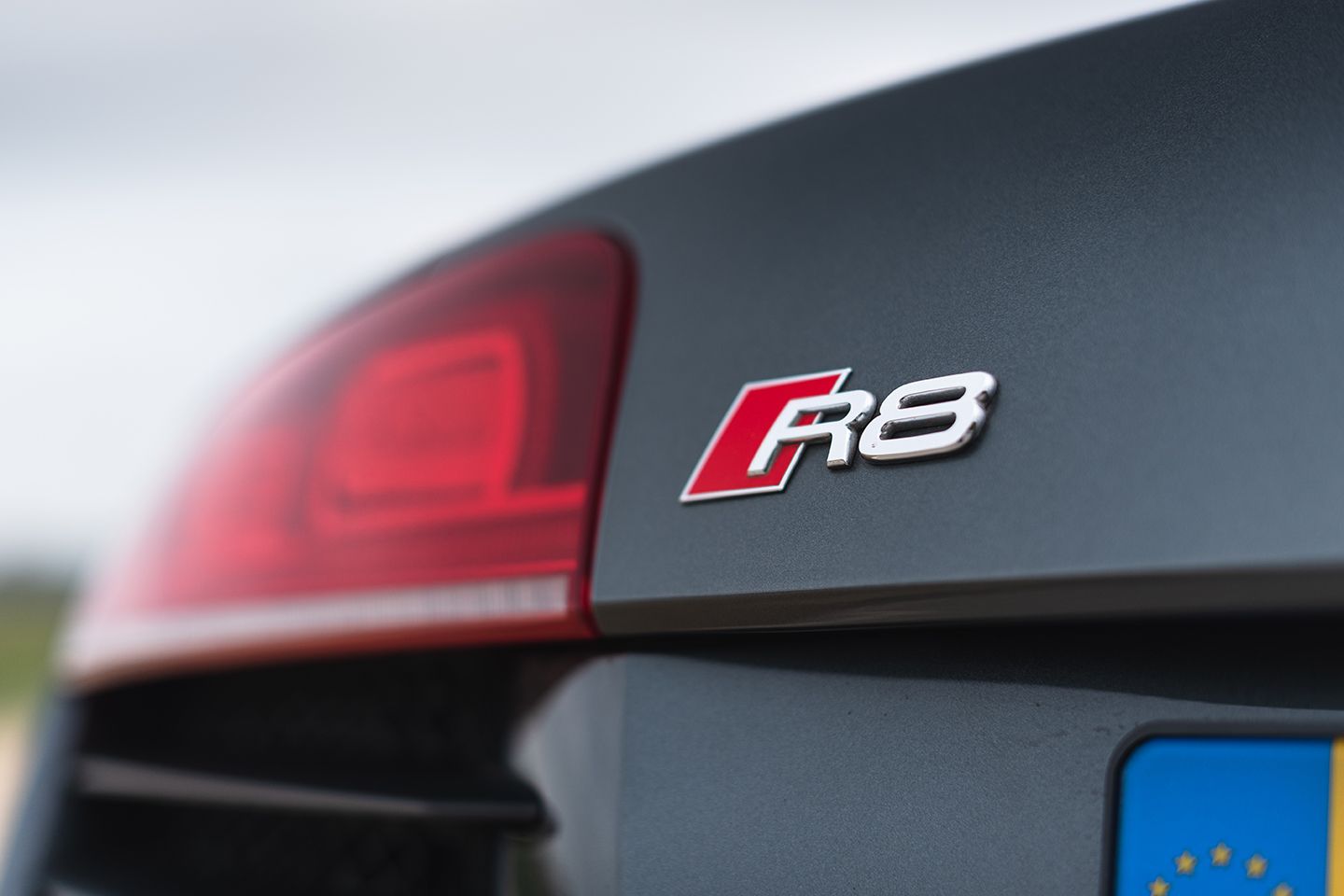
Type 42 production finished in the summer of 2015, overlapping nicely with the announcement earlier that year of the second-generation R8 which was powered by the V10 only, coming in either 540hp or 610hp Plus flavours. We’re ignoring the all-electric 92kWh/280 mile range e-tron version that also went on sale in 2015. That’s undoubtedly the rarest production R8, with fewer than a hundred sold. We’re also discounting the ultimate R8 unicorn, the 6.0 litre V12 TDi diesel with 500hp and 738lb ft that was announced (and tested by journos) in 2008. At the time Audi was talking about adding the V12 diesel to the R8 range by 2010, but after weighing the costs of properly re-engineering the R8 to accommodate the engine (large) against the likely number of diesel supercar buyers (small) they thought better of it. If you know what happened to that test car, please enlighten us on the forum.
The last real-world iteration of the Type 42 was the LMX of 2014. Based on a V10 Plus with an extra 20hp, taking it to 570hp, but no more torque, the LMX came as standard with carbon ceramic brakes, a fixed carbon rear wing, carbon splitter and canards, matt carbon cabin trim, ‘laser’ headlights adopted from Audi’s Le Mans racers, an Alcantara-lined luggage compartment and the S tronic auto, but not with magnetic adaptive suspension. It was limited to 99 examples with numbered sill plates. Most if not all of them were in Ara Blue crystal paint wth colour-matched carbon seats upholstered in Sepang Blue diamond-stitched leather. The LMX did the 0-62mph in 3.4 seconds and topped out at 198mph. The price was a similarly big number at nearly £160,000 but it sold out anyway.
R8s were lovingly built by the chosen few in the Quattro division (later Audi Sport) in Neckarsulm at the limited rate of no more than 15 cars per day. They were undoubtedly quality products, but would you gamble on one now that they’re getting on for two decades old?
Well, it might not be as much of a gamble as you might think because it seems that R8 values are bottoming out. In 2014 the Type 42 R8 entry price was £35k. Six years later, a Brave Pill feature on the R8 revealed that you could pick up a V8 for just under £30k and a V10 for £40k. All the talk then was of plummeting values, but in fact, there’s not been much downwards movement since. The starting price for a used Type 42 V8 at the time of writing in Spring 2025 was £27,000. That would get you an early (2007) 4.2 with 50-70,000 miles on it. V10s remain somewhat dearer. Although you could find repaired V10s for under £36k in early ‘25, you still needed at least £39,000 for an undamaged one. Maybe it wasn’t such a Brave Pill after all. R8 production was officially ended in 2024.
SPECIFICATION | AUDI R8 (2006-2015)
Data shown is for basic manual 4.2 V8/5.2 V10
Engine: 4,163cc V8 32v/5,204cc V10 40v
Transmission: 6-speed manual or 6-speed auto, all-wheel drive
Power (hp): 420@7,800rpm/525@8,000rpm
Torque (lb ft): 317@4,500-6,000rpm/391@6,500rpm
0-62mph (secs): 4.6/4.1 (4.3/3.6 on 2012-on S tronics)
Top speed (mph): 187/196
Weight (kg): 1,560/1,620
MPG (official combined): 19.3/19.1
CO2 (g/km): 349/351
Wheels (in): 8.5 x 19 (f), 11 x 19 (r)
Tyres: 235/30 (f), 295/30 (r)/235/35 (f), 295/30 (r)
On sale: 2006 – 2016
Price new (V8 2017): £77,000/£99,575 (V10 2009)
Price now: from £27,000/£39,000
Note for reference: car weight and power data is hard to pin down with absolute certainty. For consistency, we use the same source for all our guides. We hope the data we use is right more often than it’s wrong. Our advice is to treat it as relative rather than definitive.
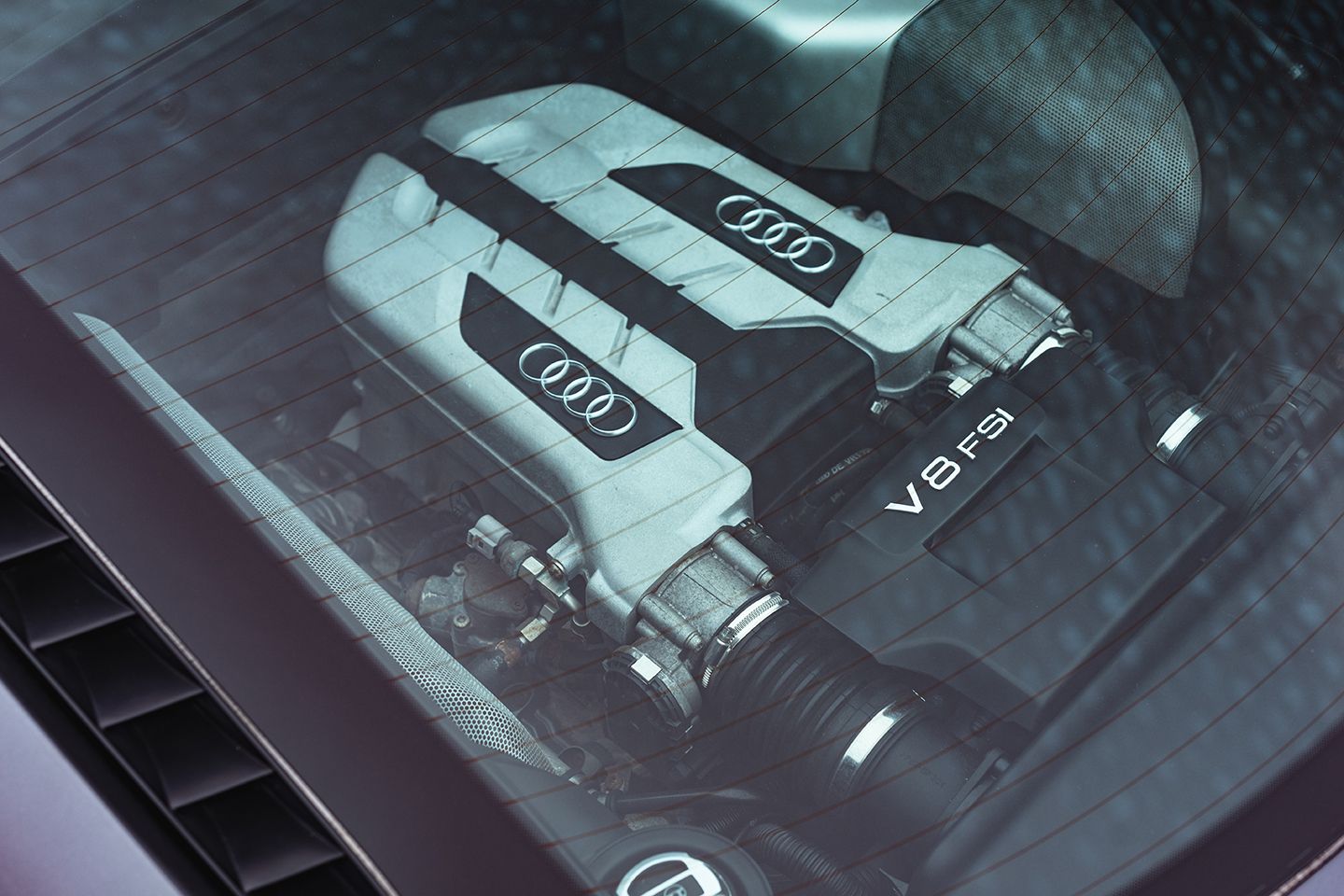
ENGINE & GEARBOX
The V8 was essentially a dry-sump version of the RS4’s motor, while the V10 had been powering Lamborghini’s Gallardo since 2003. Both had chain cam timing. On power to weight the 1,560kg V8 was running 265hp per tonne. At 1,620kg the V10 R8 wasn’t much heavier than the V8 so its p-to-w ratio was more impressive at 320hp per tonne. Default front/rear power distribution was 30/70 with more going to the fronts if the rears were struggling.
The 8,000rpm-plus howl of the ten-pot wouldn’t be denied but some preferred the lighter, snarlier feel of the V8. There wasn’t much between the two engines in terms of efficiency, however, the official combined consumption being quoted in the low 19s for both. It was worth paying the extra for premium petrol as lesser fuels could trigger engine warning lights. Radiators and oil cooler pipes were prone to rust. V10s were generally less oil-thirsty than the V8s which could quaff a litre every 1,000 miles. White smoke coming from the engine bay once the V8 is up to temp could signify a leaky valve cover gasket.
The Ricardo-built R tronic torque converter six-speed auto (or as Audi called it, sequential manual) was the more popular transmission choice despite it not being all that great and despite its £5k+ premium over the excellent open-gated manual complete with chunkily knurled aluminium shifter. This buying pattern suggested that R8 buyers might be older than the typical Audi demographic. Auto changing improved somewhat in 2012 when the S tronic dual-clutcher arrived.
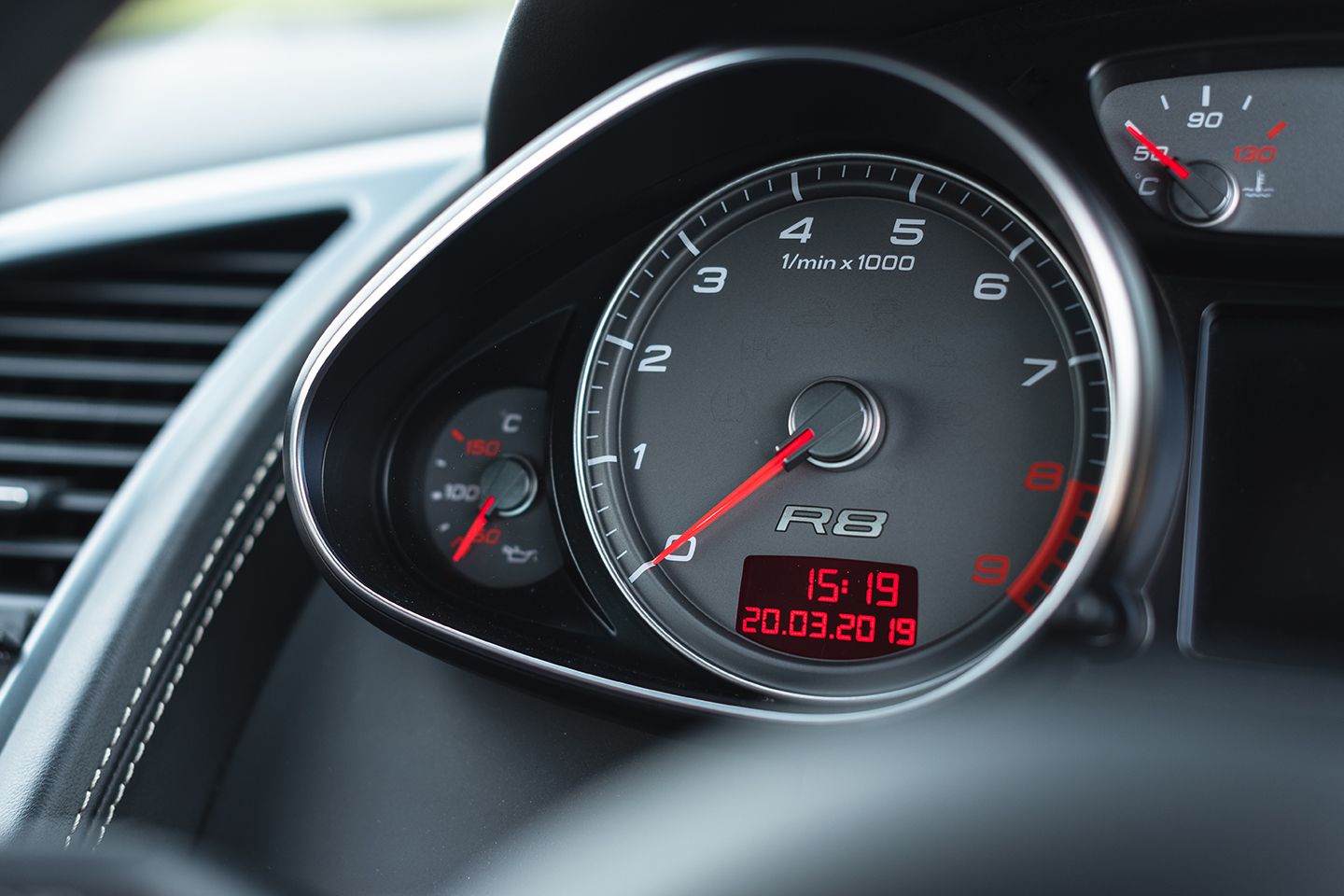
Of the 61 Type 42 V8s we saw on sale in the UK in April 2025, 24 were manuals. Of the 62 Type 42 V10s we saw, just 14 were manuals. Clutches on the manuals lasted for 40,000-45,000 miles in average use but the R tronic ones might expire in half that mileage. One PHer reported that his V10’s clutch was on the way out at 7,000 miles. We’re not sure how much they will cost to replace in 2025 but in cheaper times at the end of the 2010s it was well over £3,000 so make your own guesses from there. It’s a big job involving the removal of most of the back of the car including the exhausts.
One of the only two recalls we’re aware of that were definitely associated with the Type 42 was issued in August 2011. That was for possible fuel leaks from a chafing pipe near a heat shield on April 2009-June 2011 convertibles. The other one was issued in mid-2017 regarding leaking coolant expansion tanks on both V8s and V10s. There were a couple more to do with possible oil leakage at the gearbox breather (2018) and the chance of there not being enough fluid in the transmission (2022) but they could have been for later R8s.
Fixed servicing intervals were set at 12 months or 9,000 miles, or you could go for variable servicing which could take you up to around 19,000 miles or two years depending on the circs. Automatics needed fresh fluid every 38,000 miles. Independent German car specialists PSC Autocentre in Cheltenham will do you a basic V10 service from £422 or an extended scope one for £600, with brake fluid changes at just under £120. Supercar Service will charge £400 for an oil change and £230 for spark plug replacement, though we suspect that might be for the V8 rather than the V10. Ed at APS in Brackley has an excellent reputation for looking after R8s.
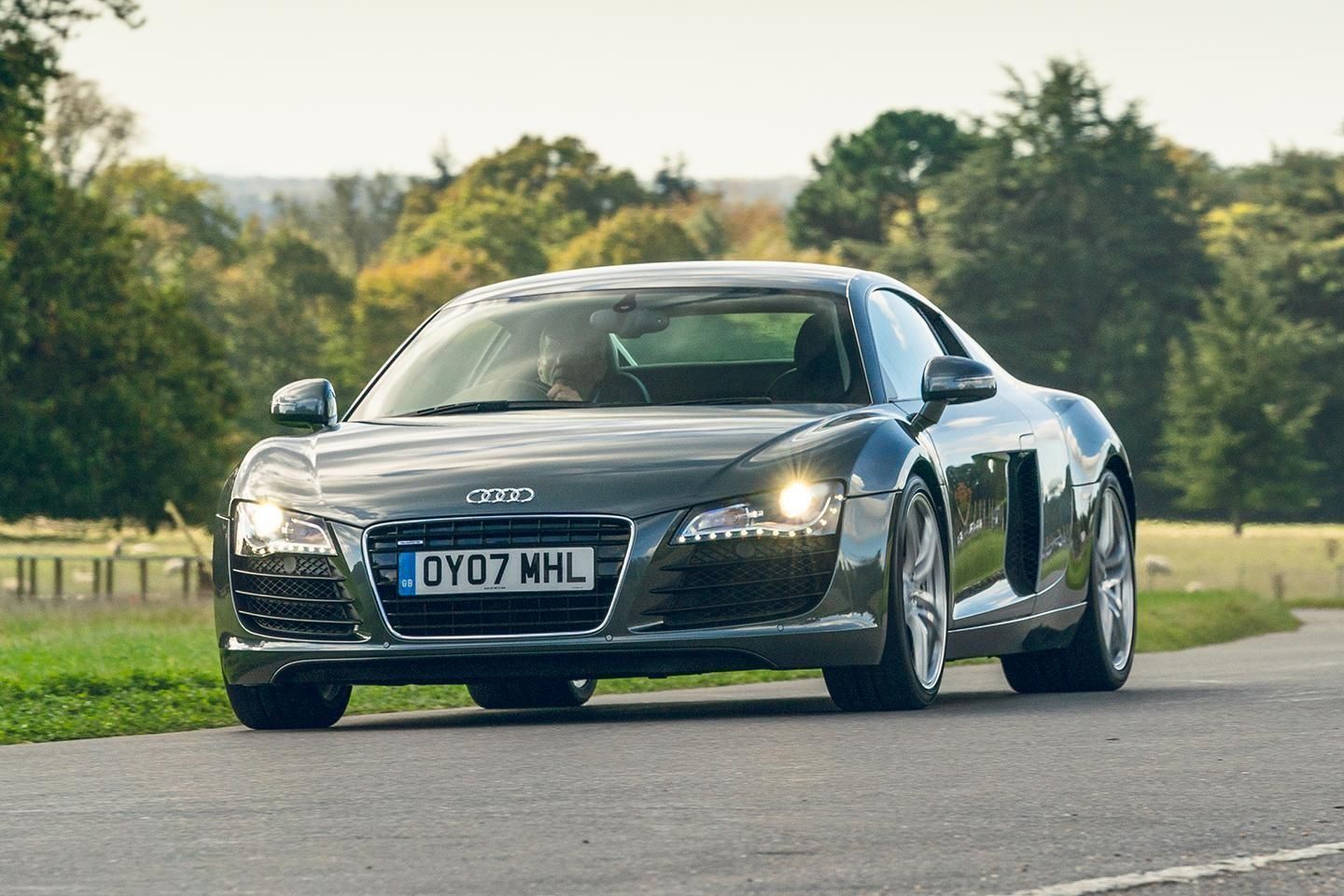
CHASSIS
As well as the normal quattro permanent all-wheel drive system the R8 had an electronic diff lock and ASR traction control. At low speeds on full lock you could feel the diffs grinding but that was a small price to pay for the peerless sense of security and the nailed accuracy of the front end.
Passive suspension front and rear was by double wishbones. Audi’s Magnetic Ride Control adaptive suspension with two selectable modes (Normal or Sport) was standard on the V10 and a worthy option on the V8 as it added a useful element of pliancy to the ride, but it was an expensive box to tick and it remains expensive today if it goes wrong, which it can do when the damper units leak. At the time of writing Audi dealers were quoting around £2,700 for one replacement damper including VAT. One aghast owner managed to haggle that down to £2,400. Thankfully the aftermarket can help at more realistic prices, but check your sources as there have been some dodgy ones coming in from the East. Lower rear wishbones can give out. Fixing that generates another big bill because a new hub carrier will also be required.
Some say that early V8s ran on 18-inch wheels but we haven’t found any evidence to confirm that. V10s were certainly always on 19-inch wheels. Standard steel brakes were 365mm front, 356mm rear, with carbon ceramic brakes available as a 12kg-saving option. Although these did last much longer than steels they weren’t everlasting. Given the age of R8s now they could be seen as a financial liability on any used car you might be thinking of buying, but if you aren’t bothered about maintaining the original spec you could avert that by going to steels.
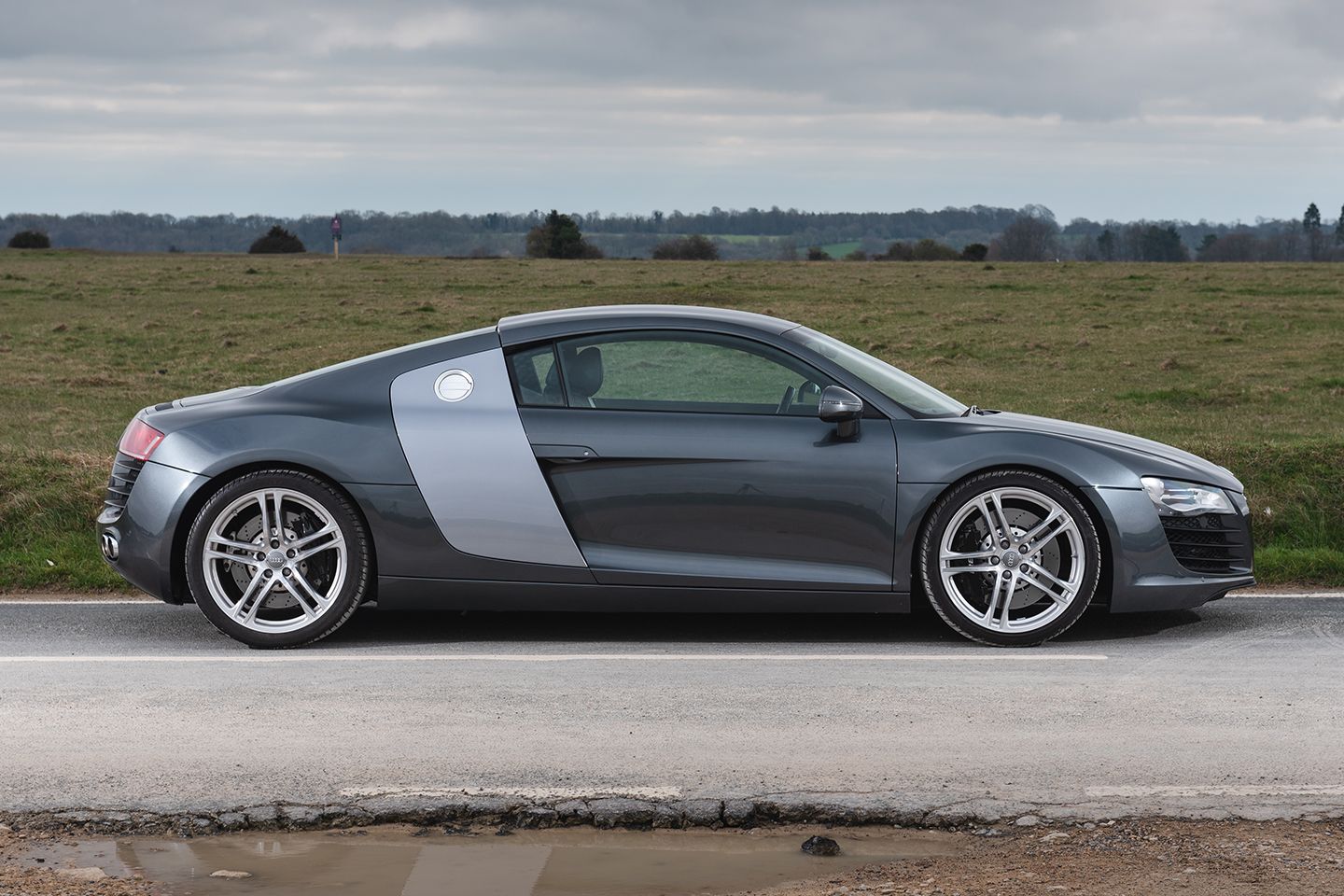
BODYWORK
Aluminium was heavily (or not) used in the construction of not just the body panels but also the suspension and the spaceframe on which both were mounted. Repairing crash-damaged parts will therefore never be easy or cheap. The doors were long and could get chipped on their rear edges as a result of opening them in car parks.
There were just two standard paints for the V8: Ibis White with Ice Silver sideblades routing cool air to the engine or Brilliant Red with same-colour sideblades. £700 bought into six more options: two metallics (Ice Silver with Apollo silver blades, or Jet blue with Ice Silver blades) and four pearls (Mugello blue with Night blue, Daytona grey with Quartz grey, Phantom black with Lava grey, or Monterey green with Deep green). For an extra £800 you could have your blades finished in Oxygen Silver. Make it £1,500 and you got Carbon Sigma. An engine cover in the same finish was £2,750.
We like the Spyder as it gave the driver access to so much more V8 or V10 sound. The fabric top folded away under a canopy in 19 seconds at speeds of up to 31mph. The V10 R8 was the first production car to come with full LED headlights.
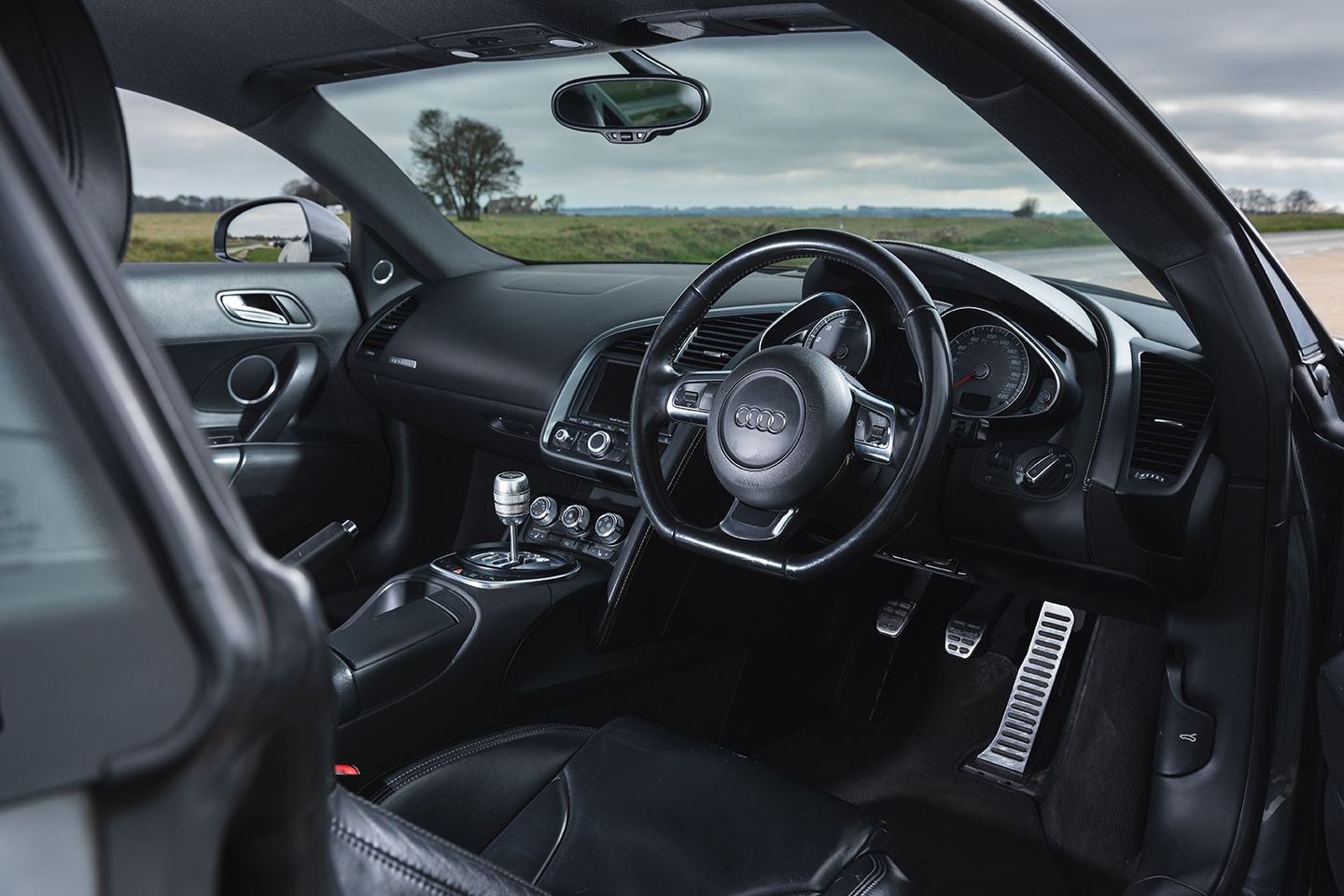
INTERIOR
Inside the R8 is where you’ll be most aware of its age. Audi thought that homogenising interiors across its entire car range would please owners of lesser models but of course the corollary of that was that it dragged halo cars like the R8 down. Even when they were new there was a bit of grumbling about the lack of a sense of occasion on entry.
On the positive side, the cabin was roomy for both humans and their various bits and pieces, and the interiors in nappa leather (extended or partial) do wear well. The R8 was of its time in that much of the stuff that you’d expect to get for free on many cars nowadays – and not just premium ones – like heated or electrically adjustable seats, hill-hold assist, light/rain sensors and cruise control were all cost options for the R8.
Sat Nav Plus was £1,800 and a 465watt 12-speaker Bang & Olufsen audio system upgrade was £1,200 but neither of these were well-loved and the B&O wasn’t seen as a major improvement over the standard setup. R8 screen graphics will seem old to anyone used to modern cars and getting your phone connected up to anything worth having could be a hassle. The only dedicated luggage space was a small one in the nose but it was big enough for a couple of squashy weekend bags.
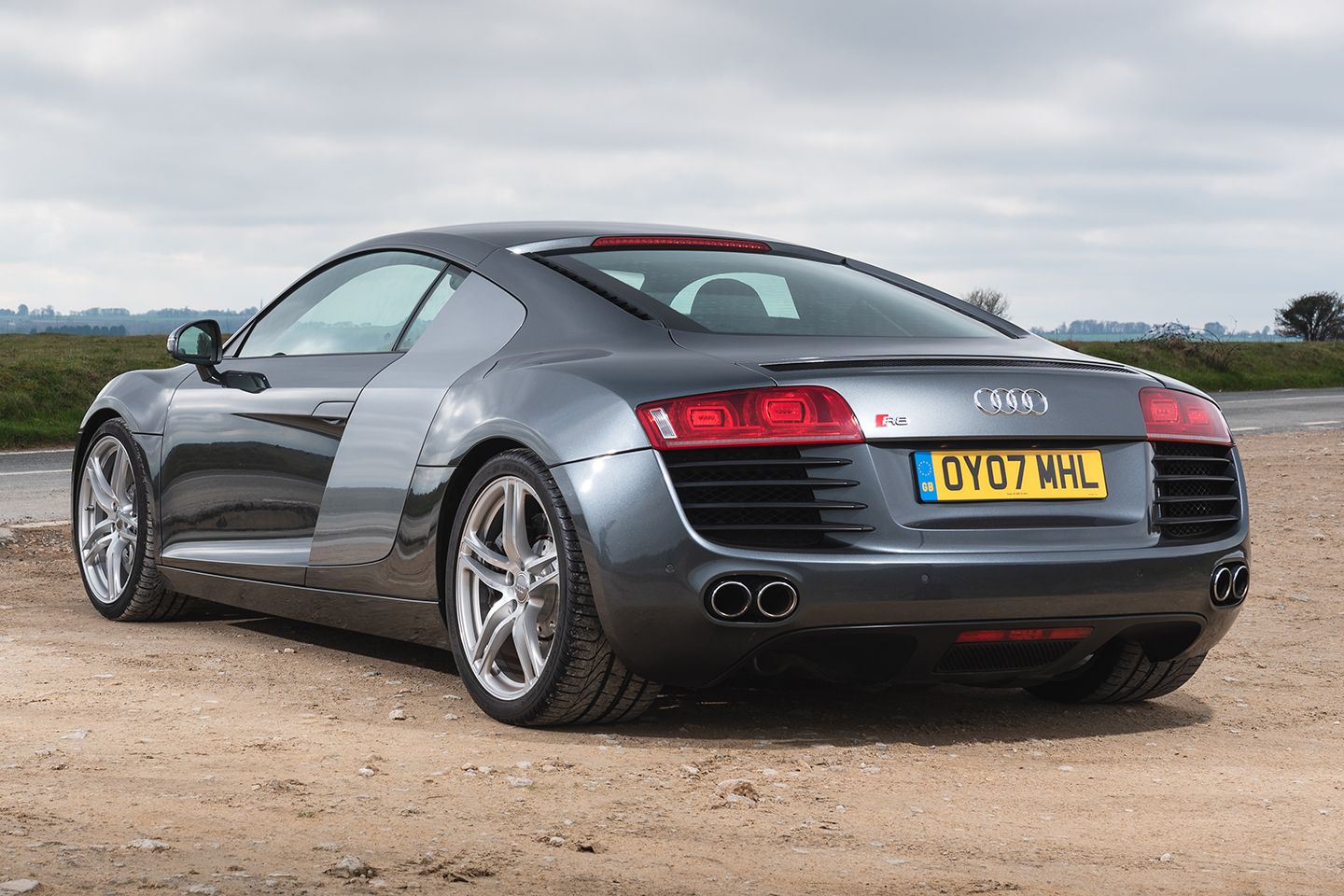
PH VERDICT
There are two tricks to appreciating the R8. One is to treat it as a fast sports car rather than a middling supercar. The other is to mentally cushion what you might think will be high R8 maintenance costs by realising that it will almost certainly cost you a lot more to keep other premium marque cars going. On top of that, unforeseen costs will be quite rare as these were very well-built cars.
The good selection of used Type 42 R8s that’s always available in the UK at any given moment reflects their durability, and the solid prices reflect the understandable love for them. The most affordable R8 on PH Classifieds at the time of writing in April was this 2007 V8 with 69,000 miles at £28,495. The only potential flies in its ointment were the fault-prone magnetic suspension and the fact that it had a clutch, but counterbalancing those was a full service history that would hopefully reassure you on both those counts, plus the pleasure of the manual shift.
Adding £6,500 to your purchasing pot chopped 28,000 miles off the odo in this later 2010 manual. Again it had the mag ride but the sounds from the non-factory audio upgrade and aftermarket titanium exhaust would hopefully take your mind off that.
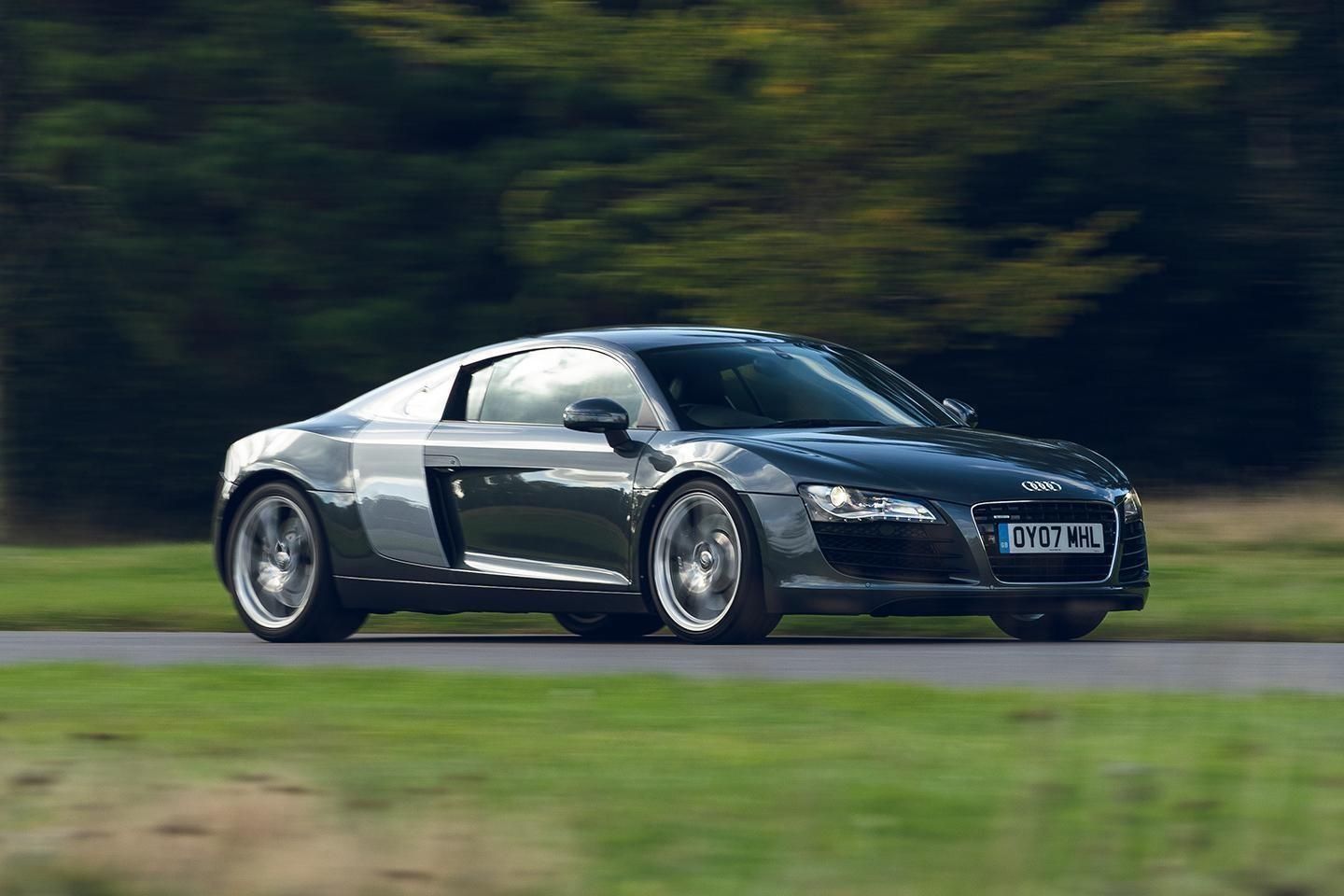
This 62,000-mile ’08 R tronic torque converter coupé was the cheapest R8 auto at £31,495. For open-air motoring this 2011 V8 auto (again an R tronic) was the lowest-priced Spyder on PH at £38,450. As noted in the overview you’ll do well to find any V10 for under £39,000. The lowest-priced examples on PH was this brace of very similarly specced Spyders within £150 of each other at just under £43k.
For just a little more money – a tenner under £44k – you could move up to a twin-clutch S tronic car in this 2013 V8 Spyder with 26,000 miles. This carboned-up 2011 Spyder in grey with crimson leather had the desirable combination of the V10 engine and the manual gearbox but you’d pay hard for the privilege at just under £50k, and that’s with 46,000 miles too.
There was quite a gaggle of V10s on PH at this sort of money, most of them Spyders, but if you could see your way clear to just under £52k that would get into this very clean looking 2013 543hp V10 Plus S tronic coupé. Predictably, the most expensive R8 on PH in April ’25 was this 5,000-mile LMX at a fiver under £130k.

